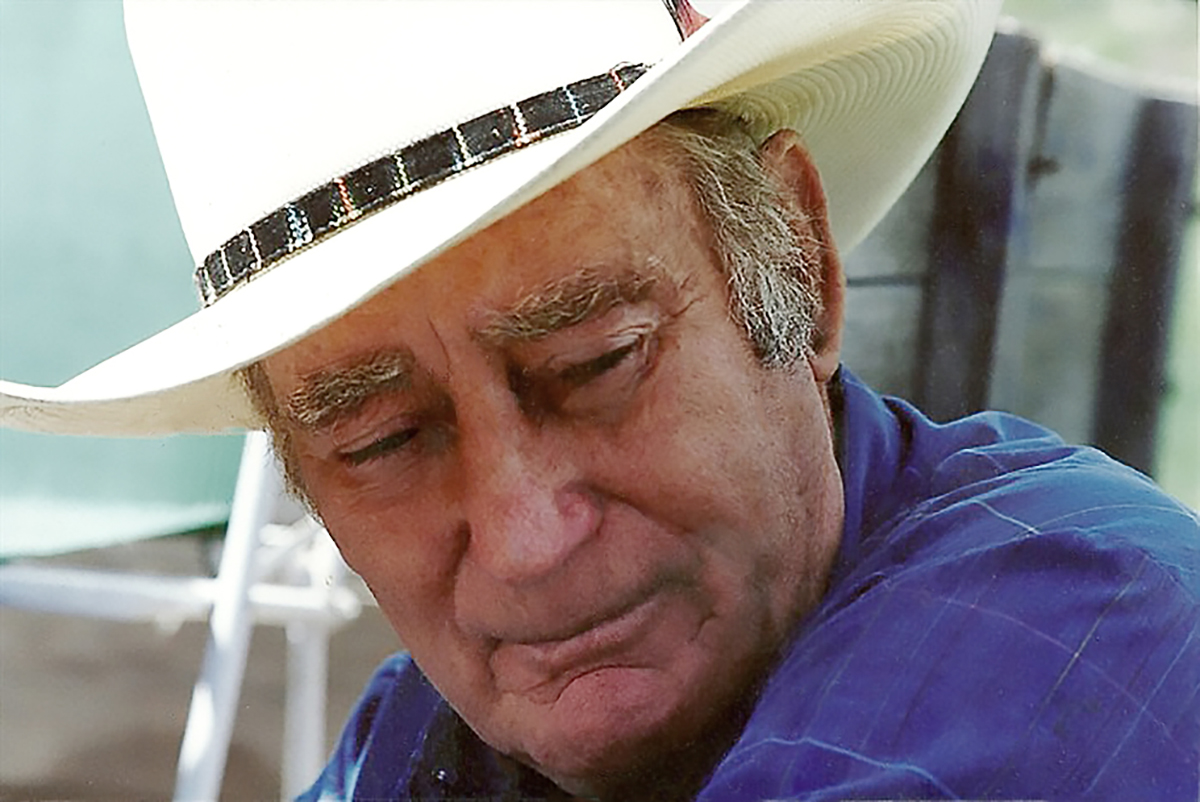
Updated: Date
Published: April 2012
‘Cowboy poet’ Tom Lynch earned his spurs
The spirit of the ‘world’s oldest cowboy’ rides the tranquil silence of the Alberta badlands
By DAPHNE LAVERS
Writing from Toronto
The first time I saw the “world’s oldest cowboy,” he was doing just what the country songs say real cowboys do. Tom Lynch was out mending fences. After checking the fence posts, Tom tightened the horizontal wires, one by one, that tied them all together. The fence marked the edge of Tom’s TL Bar Ranch. It ran down the long driveway off the Alberta highway to the big stone ranch house at the edge of the river.
Tom Lynch was tall, lean — rangy some might say — in faded blue jeans and shirt, a cowboy hat that shaded his eyes, and beat-up old cowboy boots that had been set into a lot of stirrups. Tom didn’t look anywhere near being in his mid-80s that I learned later he was.
The TL Bar is an Alberta dude ranch and a cattle ranch in some of the most beautiful and rugged country in the province. In the heart of Alberta’s badlands, it is one of the most unforgettable experiences travellers will ever find.
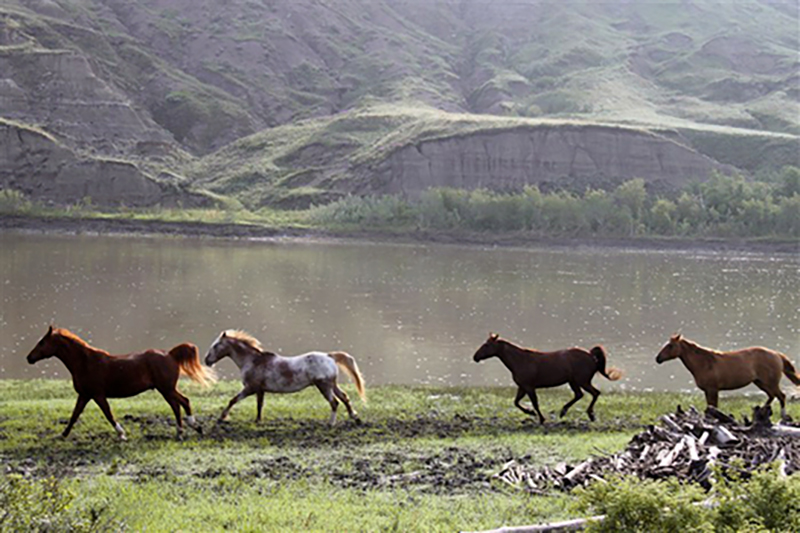
You can trail ride with the ranch hands, who will saddle up horses they have matched to riders. You can bring your own horse or RV to the campgrounds up and down the river; many of these campsites have small paddocks for your own horse or horses. You can rent canoes, and TL Bar Ranch hands will drive you upriver to a provincial park so that you can paddle down the Red Deer River back to the ranch. You can hike the badlands, wander through the local town of Trochu or drive a half hour to the world famous Tyrell Dinosaur Museum.
Between them, Tom and Willie Lynch have run the TL Bar ranch for more than 60 years — Willie is short for Wilhelmina, an Ontario girl from west Toronto — starting back in the late 1940s when Tom began leasing and then buying acreage in the badlands along the river from the Canadian Pacific Railway.
Tom rode until he was 93 years old. Sadly, he is no longer riding his trails; he passed away in 2010 at the age of 96. But there are four generations at the TL Bar these days, and Willie, her family and ranch hands still run the TL Bar, which seems to get bigger and better every year.
When you head north of Calgary on Highway 21, you pass through Strathmore and past Three Hills. A right turn off the highway into the middle of the village of Trochu continues on out of town, across the railway tracks east. That’s Highway 585, the road to the TL Bar.
The land past Trochu is wide open Alberta farmland, miles of verdant green and golden crops, gently rolling hills with the Rocky Mountains far behind and far away west. Along the small two-lane highway are a few scattered houses and farmhouses, a few falling-down, old pioneer barns, and mile upon mile of telephone poles that stretch out into the endless, see-forever horizon.
This is dinosaur countrySuddenly, the highway curves around to the left and begins an unexpected plunge steeply downward. Opening up below you, invisible from the wide prairie, is a totally different world; an ancient, sand-coloured valley rugged with hoodoos and dust, desert, scrub brush, and, far below, the massive cottonwood trees that line the Red Deer River running along the bottom of the valley.
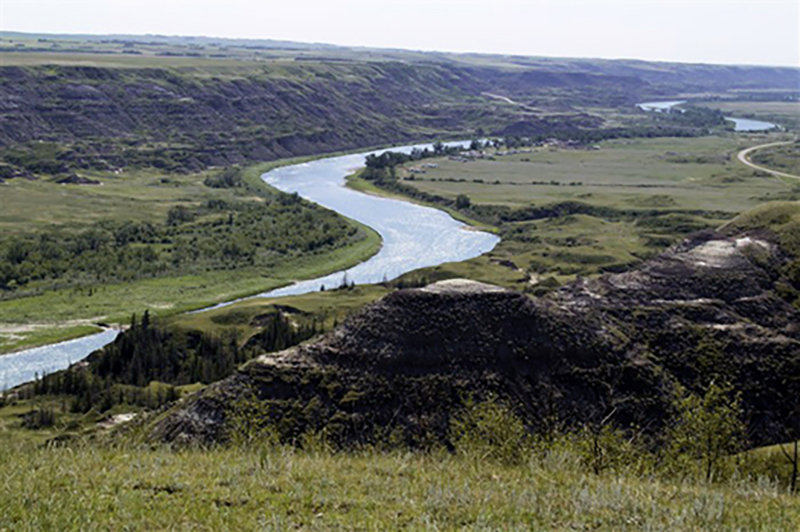
Curving along to the right below the badlands cliffs and near the bottom of the valley on the left is the simple arch sign for the TL Bar Ranch and the sloping driveway down to the ranch house. To one side of the ranch house is a wide open, fenced paddock with a small, rustic guest cabin behind it. To the other side of the ranch house are big steel-fenced paddocks and large wood and steel barns. The dirt road leading past the barns beside a big, two-storey work shed peters out onto wide open rangeland. The riverbank rangeland is separated into campsites and paddocks, the badlands looming up on either side of the valley.
The few acres of land which Tom Lynch leased and then bought from the CPR after the Second World War have grown into a big, sprawling, busy, true-blue Alberta ranch. The TL Bar is the real deal.
Running cattle along that part of the Red Deer River began in the late 1800s when Alberta was still known as part of the Northwest Territories. Just downriver from where the TL Bar now sits was the site of the pioneer Tolman family lands and the shallowest crossing of the Red Deer River in the area. Crossing the river was the shortest way to get to the town of Drumheller, so the crossing was an important waystation. The family began running the Tolman Ferry from one side of the river to the other, along with the Tolman post office and general store.
Born and raised in the area, Tom Lynch earned his cowboy spurs as a youngster and as a young man, with a wealth of experience and abilities. He operated the Tolman Ferry for a while, ran coal wagons hauled by the huge dray horses, drove herds of horses down to the Calgary Stampede, and competed at the Stampede in chuck wagon races, bareback, saddle bronc and bull riding. He broke horses at an Alberta ranch, joined the RCAF during the Second World War and began leasing and then purchasing river land from the CPR after the war.
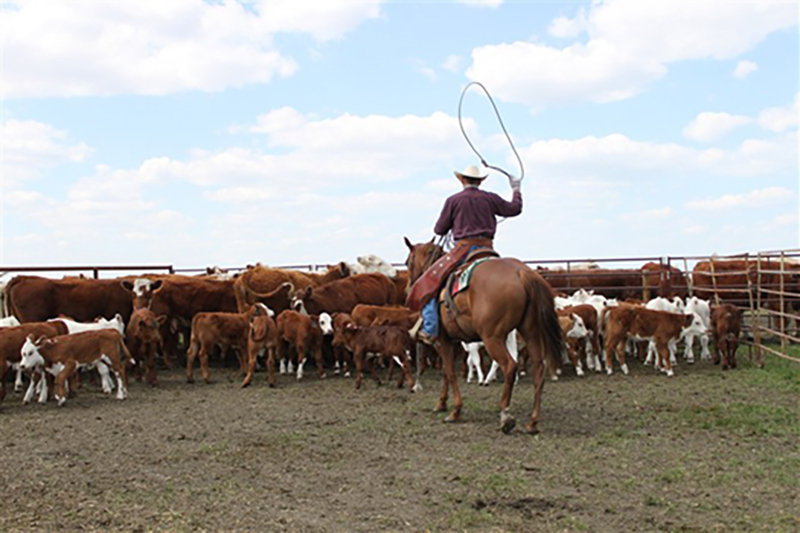
By the 1960s, the ranch house was enlarged to accommodate a growing family, and in the late 1960s, the TL Bar began taking in youngsters for summer riding experiences. It was a different kind of life for Tom and Willie because running the ranch was something they did together, every single day. Joining the Alberta Country Vacations Association a few years later set the TL Bar on the path to accreditation as a full-fledged dude ranch.
My first adventureThere’s some in my family who have been going every summer to the TL Bar since the 1980s, but it was a few years later, in the mid 1990s, that I first joined them for their customary, long August weekend riding holiday. As is my habit as a writer, I kept notes of that trip and all my subsequent experiences at the TL Bar.
August is usually hot in Alberta, and in the badlands desert country, the heat of the day only begins to cool around dinnertime. The sun sets late at that time of year, around 9:30 or 10 p.m., but down in the badlands valley, the welcome evening shadows arrive a bit earlier and dusk lasts for hours. That very first evening, as we all settled into our cabins and rooms, unpacking clothes, boots, hats, jeans and food for the weekend, a couple of the ranch hands came down to see us.
“We were wondering if you could give us a hand tonight,” one of them said, a young teenager who clearly knew her way around both horses and ranch. “We’ve got some cattle on the lower pasture and we have to drive them up to the high pasture tonight. It’s the long weekend and we’ve got campers and camper vans coming in, and they don’t really like waking up to cattle outside their trailers.”
The TL Bar hosts visitors from all over the country and all over the world to ride the trails, swim in the river, canoe and kayak, and hike through the badlands. But the TL Bar is also a year-round working cattle ranch, running its own herd of cattle and boarding a number of horses whose owners come out to ride when they can.
Since my family grew up in Alberta, we’re familiar with horses and ranches though not, by any stretch, expert in either. We all agreed at once to the ranch hands’ request — an after-dinner trail ride with a purpose! But my significant other at the time, now my husband, is a Toronto boy, born and raised. The closest Rod had ever come to horses was at the Toronto Royal Winter Fair. He was, however, wearing jeans and, significantly, cowboy boots. Since he had arrived with me, it was simply assumed that he could handle a horse and was, without question or second thought, included in the team for the roundup.
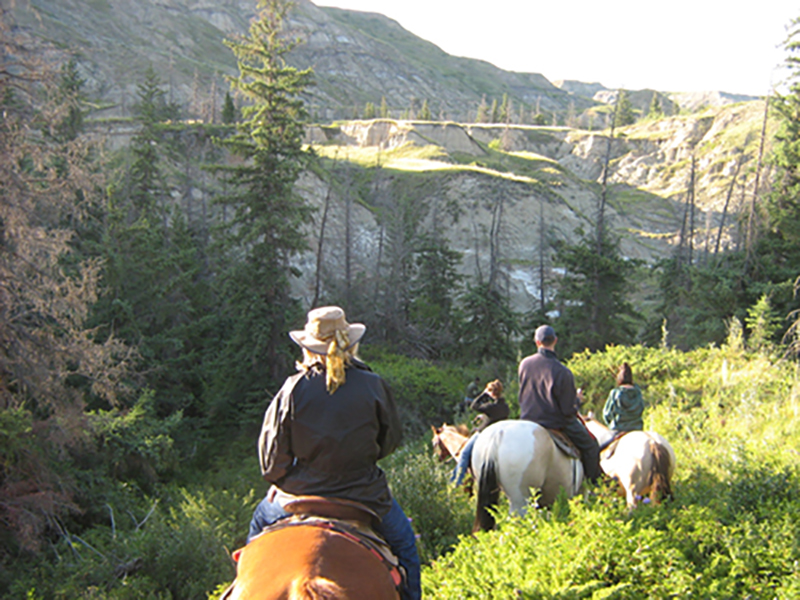
It was an adventure. The ranch hands saddled up horses for all of us, with Rod on a 25-year-old, round, but exceptionally sure-footed little mare called Joy. Riding across the pasture next to the barns we saw the grazing cattle spread out across the prairie, and just as you see in the old western movies, riders began flanking the cattle and slowly herding them towards the far end of the pasture. And there, in medieval terms, be dragons! — at least to an absolute beginner of a rider. We rode up the dried mud hills, the cattle periodically trying to scatter off into the sparse bush.
At the top of the first hill was a steep trail downwards. It led across and around a narrow footpath through bramble brushes to a ledge of rock with a dropoff on one side of about 10 feet down into a dried creek bed. Past that, a hard-packed, dirt trail climbed up and up, until finally a three-foot step up led to the higher pasture, the badlands valley stretching out behind us.
Joy, the sure-footed little pony, stood at the top of the hill, looked down and simply refused to budge. She dug in her hooves and stayed put, blithely ignoring the hoots and hollers, the prods and encouragement from all and sundry. Discretion, together with a healthy dose of apprehension being the better part of valour, Rod decided that since the horse knew these parts and knew what lay ahead, he was not about to argue with several thousand pounds of equine muscle. He decided to defer to her good judgment and stayed put.
The rest of us, in various groups, drove the cattle down the narrow path, stepped very, very carefully across the rock ledge above the creek bed, around the wind-carved hoodoos that rose beside the path, and up that narrow mud trail to the rock step. With some prodding and hollering, the cattle were driven up what appeared to be a two-foot-high three-step-up, across the desert landscape of hoodoos and then further up to the higher pasture.
Then we had to return. That three-step-up on the way up looked like a sheer cliff on the way down, with steep hillside below and a sharp right-hand turn as the dirt cliff ended. It felt like jumping off the edge of the world.
“Loosen up on the reins, give the horses their heads, lean back and hang onto the back edge of the saddle,” the ranch hands shouted cheerfully. My horse walked slowly to the edge, which from the back of a 15- or 16-hands-high horse looks like — and is! — a long, long way down. He dropped his head, and slowly and carefully clomped one hoof and then the other down the step. I hung on for dear life. The other two hind feet followed, the horse stepped and slid down the dirt, we made that right-hand turn safely and now only had to navigate around the rock ledge. Made it!
Riding the badlandsThe riding trails at the TL Bar are among the most challenging in the world. These are not the customary flat, well-trodden urban forest paths slogged along by 20 to 30 tender-butt neophytes walking slowly behind a lead hand. This is desert, badlands country complete with sagebrush and wind-carved cliffs.
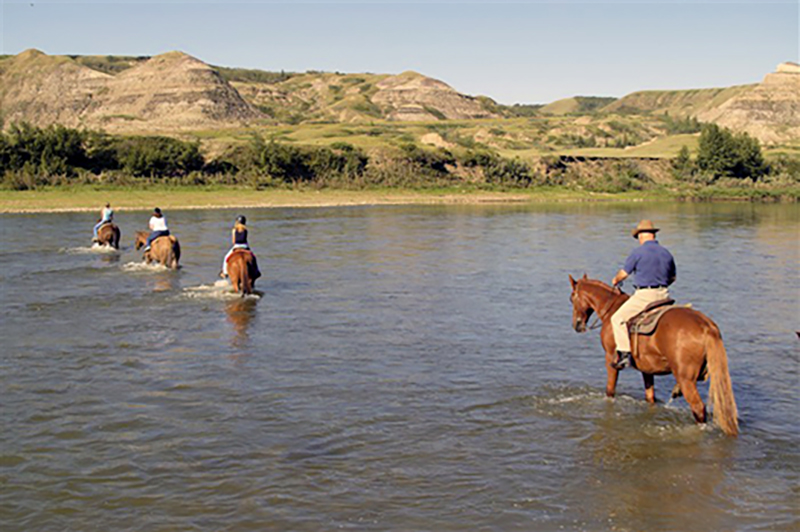
Depending on the ability of the riders and the length of the ride, the trails can be rugged, steep and rocky; or for absolute beginners, fairly level through gently rising hills. You learn quickly that horses prefer to skitter and scamper uphill, breaking into a slow trot or even a gallop if the terrain looks clear. Downhill, horses prefer to put their heads down, look where they’re going and pick their way along some of the hard-packed, dirt switchbacks and through some of the rock-strewn creek beds along the path.
But if you know anything about horses, you can see that these horses are exceptionally well-muscled; they’re properly shod, they’re alert, and, most important of all, they know and can handle all the terrain of the TL Bar. For them, the trail rides provide a varied choice of pleasurable excursions. The horses range in age from about five-year-olds to 25-year-olds, such as Joy was that year. Each and every one has been ridden extensively through the ranch lands long before any inexperienced riders are ever placed astride them.
There were rare and special occasions when Tom would join us on an outing, riding his beautiful Appaloosa, Red, and in later years, his pretty palomino, Casper. Tom brought up the back of the pack, riding silently, gazing at the lands and keeping an eye on those guests with less riding experience, but never directing or interfering with the trail hands or the lead rider.
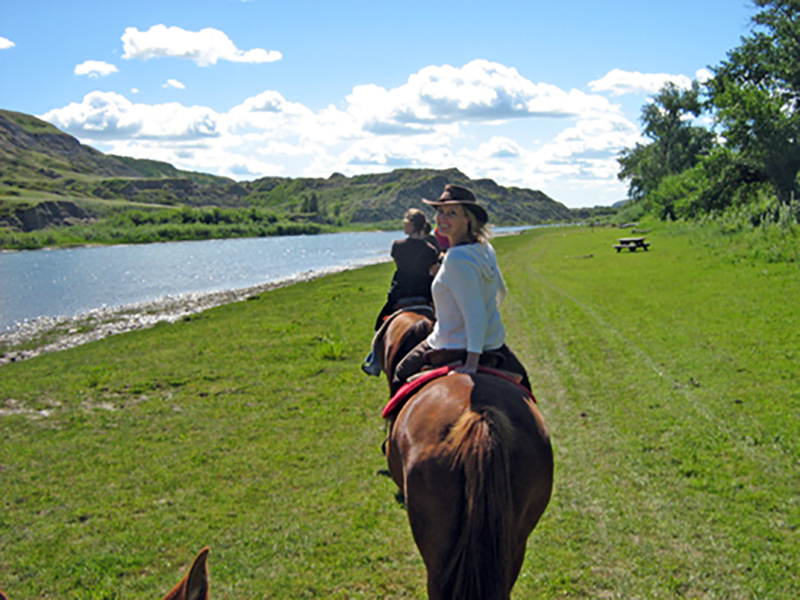
Once in a long while, Tom would chat with visitors and folks who had returned to the ranch for a few years in a row. He was well known in the area for his strong, quiet views on politics, on the foolishness of most governments, on the iniquity of high interest rates young people starting out had to pay on farms and ranchland, and on the overly generous salaries and pensions of politicians of all stripes.
In addition to being a true blue rancher and cowboy, Tom Lynch was also what’s called in the West a “cowboy poet.” His simple poetic eloquence spoke to the range and the open prairie and fellows riders. And second nature to Tom was the knowledge of smart and dumb ways to break and handle horses.
He knew horses and he knew riding, did Tom Lynch. He took one group out on a ride one day, went into the barn to get his own horse saddled and came out to the paddock to find one rider screaming her head off. She was hauling back hard on both reins, and the horse, following instruction, was running backwards!
On another ride, Tom was astride his little palomino and one of the riders took off her jacket under the warming sun. With the rustling and movement of a jacket behind, her horse spooked and began dancing sideways. The rider, also spooked, held her jacket off to the side, which spooked the horse even more. “Drop your jacket!” Tom shouted across the paddock. The rider dropped it onto the ground, and the horse settled down immediately.
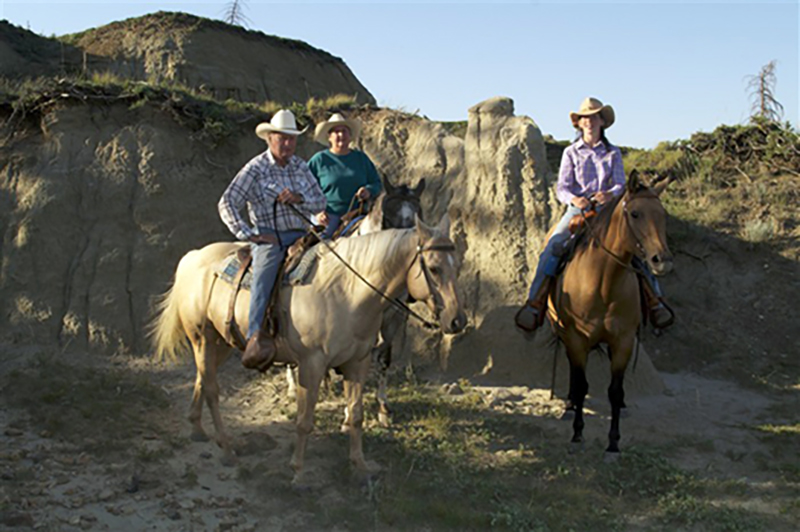
One year, we rode as a posse in the muddy grass alongside the river, the prairie strangely lush but the baked badland hills rising on either side, still carved by the winds. The trail hands checked to see if everyone was okay crossing the river, and one by one, the horses splashed into the shallows. As the horses moved deeper into the middle of the river, the waters rose to just below the stirrups and then, for those on the shorter horses, it was either pull your knees up to the saddle horn or stay in the stirrups while your boots filled with river water. That was an exciting ride, the horses pulling strongly against the current, stepping carefully across the pebble bottom on the far side, and shivering themselves off when we reached dry land again.
My most exciting rideThe most exciting ride I ever was on included about seven or eight riders of whom at least three were ranch hands. The guest riders were all fairly experienced, and we headed off across the front paddock, crossed the highway and began climbing the bramblebush hillside to reach the top of the badlands. We walked the horses slowly up small ascending switchbacks, picking our way along the narrow path.
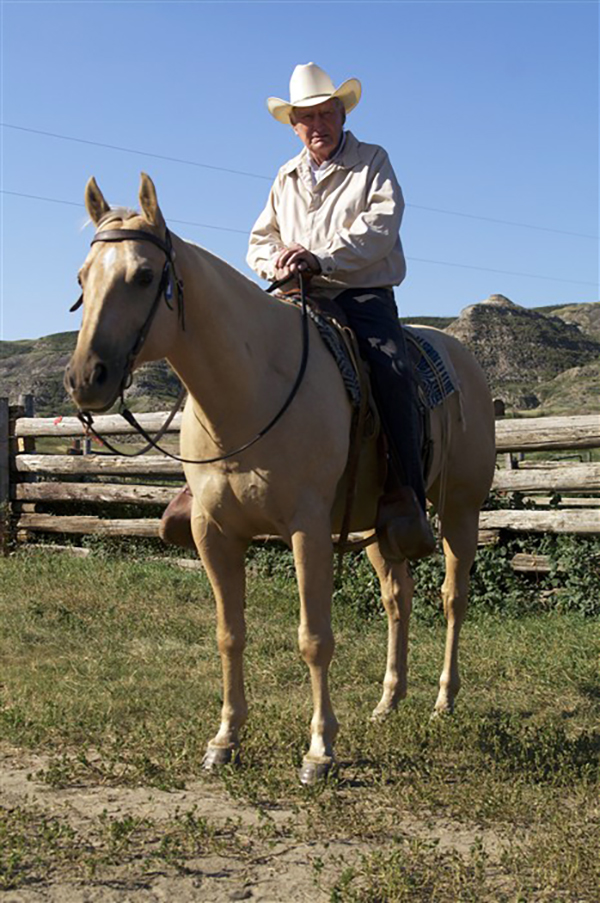
I was riding Cody, a big, beautiful palomino with golden mane and tail. Cody was a treasured mount, alert, sure-footed, responsive with ears pricked forward, paying attention to the trail. Behind me was Nipper, an aptly-named dark brown horse that moved with alacrity both up and down the hills. But that horse was named for a reason, which I found out halfway up the badlands hills.
Sometimes, some horses just get themselves in hurry mode. They’re anxious to reach the top of the hill and they’ll start crowding the horse in front of them. Experienced riders — and for sure, our trail guides — know that this is normal, and handle their mounts accordingly. Nipper got a little pushy; Cody kicked out his back hooves just a little bit, and Nipper, true to form, gave Cody a little nip on his butt. And just like in the old westerns, Cody reared up on his hind legs.
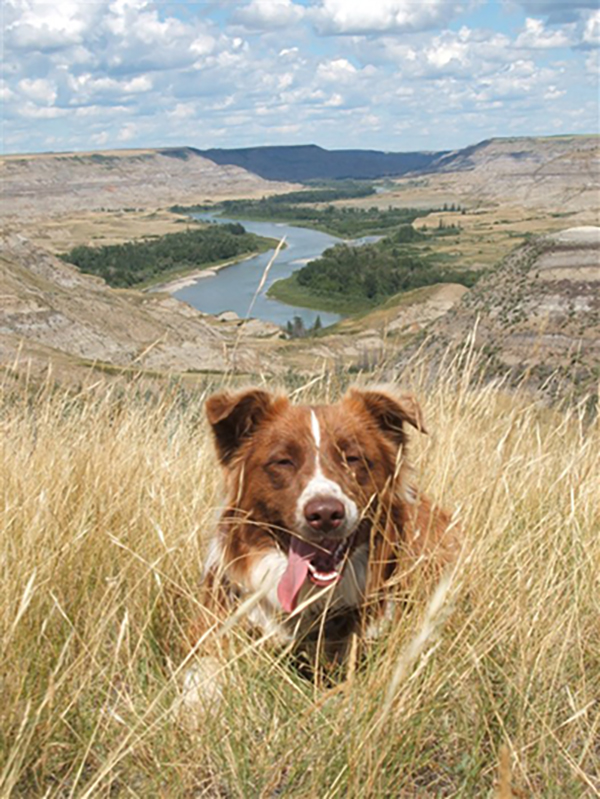
I’m no expert rider, but there have been those in my family who “rode trick” as the expression goes. Riding trick is, for example, when riders stand up on the back of a cantering or galloping horse, even bareback, or swing themselves down off the saddle horn at a full gallop to pick something up off the ground. Trick riders can ride backwards as easily as frontwards and they are as comfortable on a horse as anyone else is in an easy chair.
It may be that the ghosts of family past endowed my reactions to Cody rearing because I don’t feel I can take much credit for what happened next. By instinct, I hauled back on Cody’s reins, turned him to the side where he plunged a couple of steps down off the trail, and stepped smartly around Nipper and back onto the trail behind. It all took only seconds and the trail ride continued as before, just in a slightly different order. And I kept behind Nipper for the rest of that ride!
It’s a curious part of the world, these ancient desert badlands. Springtime crocuses pop up from the grasses, their pale mauve and yellow a visual gem in the midst of prairie grassland. At the edge of the guest cabin porch is a rock garden, created and tended by Willie, Tom’s wife. It is scattered with pink and white petunias; purple, yellow and rich royal Chinese red-purple pansies along with iris and fern – a surprising and beautifully colourful oasis in the desert sand.
So now four generations of Lynches live and work at the TL Bar. Willie handles the rental of the “self-catering” cabin, where my group stays with kitchen, shower and sleeping accommodation for at least six. Willie also manages the canoe outings for visitors. Granddaughter Jaime, who now lives at the TL Bar with her husband Ricky, manages the trail rides and riders, while Ricky breaks and trains horses.
Tom and Willie’s daughter-in-law, Deanie, manages the campgrounds and the equestrian grounds. She also handles the rental of the “rustic cabin,” a smaller kind of bunkie designed only for sleeping. Tom’s Appaloosa Red and energetic Nipper, who is about 20 years old now, are still at the ranch, and probably will be for a few years to come.
Silence of the badlands soothes the soulOne year, a snowstorm descended on the hills above the valley in mid-July, leaving behind overnight a winter wonderland that transformed just as quickly by midday back into hot, sagebrush desert.
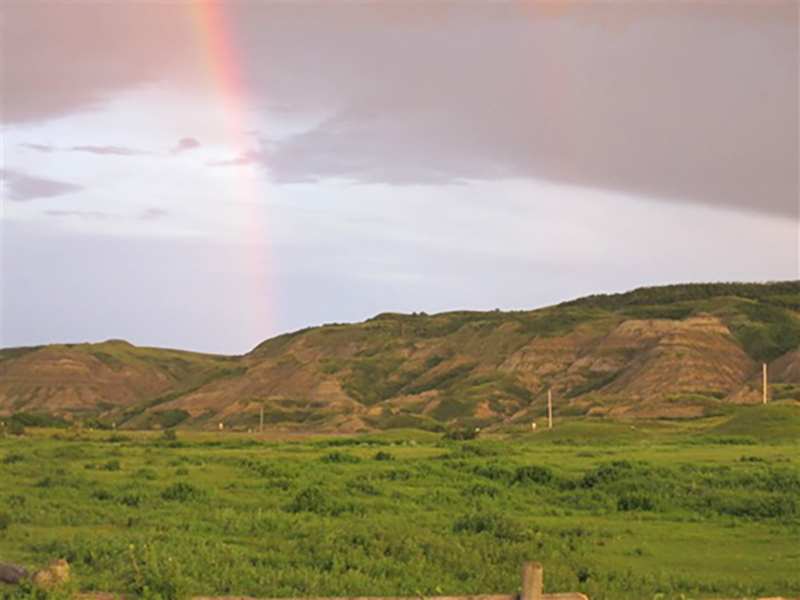
Some nights just as dusk falls, you can hear the coyotes calling along the ridges of the badlands, the conversation fading or closing in as those wild dogs choose their trails for the night. The campfires are lit around the cabins and the campgrounds, and the prairie sky is filled with stars more brilliant in the soft blackness of the valley.
Some days, in the late afternoon, a still perfect silence descends on the ranch, broken only by the soft clacking of the waxy cottonwood leaves and the clicking of the grouse in the fields. It’s a healing silence, the empty prairie nothingness of no sound, no movement, no motion of any kind. The deep tranquil silence that soothes the soul and stills the mind.